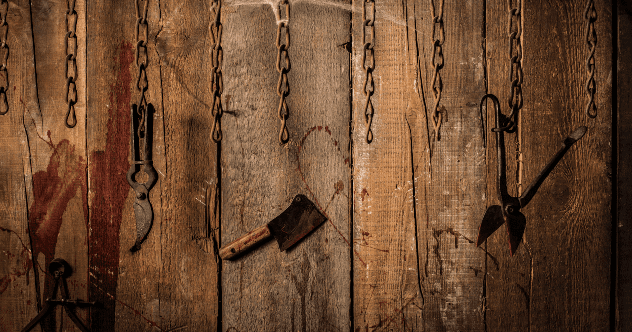The justice system aims to ensure consequences fit the crime. Throughout history, societies have used punishments ranging from fines to executions to deter wrongdoing. However, some punishments, particularly in the Medieval era, were so extreme they instilled widespread fear. This list explores ten such punishments that, in retrospect, were excessively cruel.
The Blood Eagle
The Vikings, known for raiding monasteries and coastal cities, were fearsome warriors. Yet, their society had rules for punishing wrongdoers. The Blood Eagle was a particularly gruesome Norse execution reserved for those who murdered a victim’s father.
The executioner would open the offender’s back, separating the ribs from the spine and twisting them upwards to resemble wings. Then, the lungs were pulled out and draped over the “wings,” and salt was added to the wound for maximum pain. The excruciating pain led to eventual death.
Lingchi – “Death by a Thousand Cuts”
Ancient China had a brutal punishment known as Lingchi or Slow Slicing, reserved for major crimes like treason and mass murder. As the name suggests, it involved slowly killing the condemned.
The executioner would tie the accused to a post and methodically cut away portions of their body, revealing underlying tissue. The process varied by region; some victims suffered over 3,000 cuts. The time it took depended on the officials’ mercy.
Execution by Elephant
Elephants, revered in some cultures, were used as instruments of punishment in others. In South and Southeast Asia, they were employed to trample the accused to death.
In India, this punishment, known as Gunga Rao, was for crimes like rebellion and tax evasion. Elephants crushed victims methodically, starting with the lower limbs. In Thailand, elephants tossed the accused in the air, while in Vietnam, they charged and crushed them.
Death by Cannon Fire
Cannons, powerful weapons of war, were also used for executions in Punjab under British control. This method was particularly brutal and unpopular.
Victims were tied to the front of cannons, with their buttocks covering the mouth. When fired, the cannon obliterated the accused, leaving a gruesome scene covered in blood and remains.
Keelhauling
In the age of sailing, naval captains punished disloyalty with keelhauling. This punishment, perfected by the Dutch army, involved dragging the offender under the ship from one side to the other.
The keel, or ship’s bottom, could tear the person apart, and drowning was common. Even if the person survived, they were left with horrible, lifelong scars.
Drawn and Quartered
Drawing and quartering was one of the cruelest punishments, designed to instill fear. The victim was tied to a horse and dragged to the gallows, where the execution took place.
At the gallows, the accused was hanged, beheaded, or disemboweled. Quartering involved splitting the body into four pieces by tying it to two horses forced to run in opposite directions, tearing the body apart. This spectacle was reserved for treason to provide ultimate humiliation and entertainment.
Death by Boiling
In the 1500s, boiling was used as a method of execution. Prisoners were placed in large containers filled with boiling water, oil, wax, or wine and left until they died.
This method prolonged suffering. Emperor Nero boiled early Christians in oil. In England, Henry VIII used it for treason or poisoning. The public watched as a human was boiled alive for up to two hours.
Torture by Rats
Torture by rats, familiar from Medieval films, involved tying a victim down and placing a bucket on their bare stomach or chest. A hungry or diseased rat was placed inside the bucket.
The bucket was heated, causing the rat to nibble at the victim’s flesh to escape. The rat would eat its way into the flesh, causing immense pain. Survivors were left with wounds that took a long time to heal.
Poena Cullei – Sewn in a Bag
In Roman society, parricide, or killing relatives, was severely punished. Poena Cullei, meaning Sewn in a Bag, was the standard punishment. The condemned were beaten with rods and then sewn into a leather sack with a rooster, snake, monkey, and dog.
The chaotic mix of animals ensured further suffering. Executioners then threw the sack into the sea, ensuring death by animal attack or drowning.
Scaphism
Scaphism, also known as The Boats, was reserved for those guilty of murdering royalty. It involved trapping an individual between two small boats or tree trunks in a swamp.
The victim was force-fed milk and honey to cause diarrhea, and the mixture was applied to their exposed skin to attract insects and rats. Death resulted from being eaten alive, exposure, dehydration, and wounds.
These historical punishments highlight the extreme measures societies have taken to enforce justice. From the gruesome Blood Eagle to the agonizing Scaphism, these methods reflect a dark side of human history, where retribution often overshadowed proportionality.
What do you think about these punishments? Leave your comment below!










